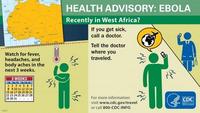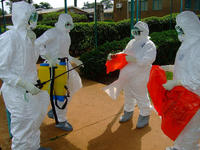-
Dallas Ebola patient was sent home as a result of a flaw in software used by many hospitals

Before Thomas Eric Duncan was placed in isolation for Ebola at Dallas’ Texas Health Presbyterian Hospitalon 28 September, he sought care for fever and abdominal pain three days earlier, but was sent home. During his initial visit to the hospital, Duncan told a nurse that he had recently traveled to West Africa — a sign that should have led hospital staff to test Duncan for Ebola. Instead, Duncan’s travel record was not shared with doctors who examined him later that day. This was the result of a flaw in the way the physician and nursing portions of our electronic health records (EHR).EHR software, used by many hospitals, contains separate workflows for doctors and nurses.
-
-
Sandia researchers find clues to superbug evolution
Imagine going to the hospital with one disease and coming home with something much worse, or not coming home at all. With the emergence and spread of antibiotic-resistance pathogens, healthcare-associated infections have become a serious threat. On any given day about one in twenty-five hospital patients has at least one such infection and as many as one in nine die as a result, according to the Centers for Disease Control and Prevention (CDC). A team of Sandia National Laboratories microbiologists for the first time recently sequenced the entire genome of a Klebsiella pneumoniae strain, encoding New Delhi Metallo-beta-lactamase (NDM-1). Klebsiella pneumoniae is not typically a ferocious pathogen, but now armed with resistance to virtually all antibiotics in current clinical use.
-
-
Quarantine works against Ebola but over-use risks disaster
Quarantine, in the form of isolation, is an important component of the response to Ebola infection. As people are infectious only once they develop symptoms, isolating them and having health-care workers use personal protective equipment significantly reduces the risk of onward transmission. While quarantine is an important weapon in our arsenal against Ebola, indiscriminate isolation is counterproductive. The World Health Organization has warned that closing country borders and banning the movement of people is detrimental to the affected countries, pushing them closer to an impending humanitarian catastrophe. Still, this didn’t stop Sierra Leone from imposing a stay-at-home curfew for all of its 6.2 million citizens for three days from 19 to 21 September. Quarantine is an excellent measure for containing infectious disease outbreaks, but its indiscriminate and widespread use will compound this epidemic with another humanitarian disaster.
-
-
U.S. hospitals unprepared to dispose of Ebola-related waste

A board of biological safety experts has warned that many U.S. hospitals may be unprepared to dispose of Ebola-related waste safely, should the disease arrive in any great number within the mainland. Many waste management companies are refusing to perform any service where waste items – such as soiled sheets and medical protective gear involved with treating the disease – would have to be handled. They cite federal guidelines which state that such items would require special training and packaging by people with hazardous materials training.
-
-
CDC: First Ebola case diagnosed outside Africa; patient being treated in Dallas, Texas
The Center for Disease Control and Prevention (CDC) yesterday evening announced the first case of Ebola to be diagnosed outside Africa during the current outbreak, which has so far killed more than 3,000 people this year. The CDC said the patient left Liberia on 19 September, but did not develop symptoms until 24 September, when he was already in Dallas. He was admitted to the Texas Health Presbyterian hospital in Dallas on Sunday, 27 September. The possibility of treating the patient with experimental therapies was being discussed with the patient’s family. If the Texas patient receives the experimental treatment for Ebola, he will be the fifth to do so in the United States (a sixth American – a carrier of dual American-Liberian citizenship who worked for Liberia’s Ministry of the Treasury – contracted the disease in Monrovia in July and dies a few days later in a Lagos, Nigeria hospital). The FDA has issued warning letters to three privately held companies marketing what they claim are treatments to prevent or treat Ebola.
-
-
Contrary to scientific evidence, the media continue to fan fears of airborne Ebola infection
Despite solid evidence presented by scientists to quell rumors that the deadly Ebola virus could be passed through the air, many American media outlets continue to raise alarm and fuel debates with flimsy sources.These outlets publish articles which revive an earlier scientific debate over whether the Ebola virus can be transmitted through the air — but scientists say this debate has been decided, and that the Ebola virus cannot be transmitted through the air.
-
-
Ancient plague offers insights on how to improve treatments for infections
Dangerous new pathogens such as the Ebola virus invoke scary scenarios of deadly epidemics, but even ancient scourges such as the bubonic plague are still providing researchers with new insights on how the body responds to infections. Researchers have detailed how the Yersinia pestis bacteria that cause bubonic plague hitchhike on immune cells in the lymph nodes and eventually ride into the lungs and the blood stream, where the infection is easily transmitted to others. The insight provides a new avenue to develop therapies that block this host immune function rather than target the pathogens themselves — a tactic that often leads to antibiotic resistance.
-
-
Models of Ebola spread cannot model people’s behavior
The most effective way to limit the spread of the Ebola virus is by tightly quarantining infected individuals in hospitals, Ebola treatment units (ETUs), or in their homes. The developer of a sophisticated model to predict the pace and scope of the spread of Ebola admits that the most important variable — predicting the most effective way to convince infected individuals to report their cases to health authorities and be admitted to a quarantined facility, or even just stay at home – is beyond the model’s reach. “The trouble is to get people to believe that going to the hospitals is in their best interest,” said CDC’s Dr. Martin Meltzer. “We’ve got to get people to understand that. You can go around to villages and cities and slums all you want and say, ‘If you’re ill, go to the hospital.’ Why should anybody believe? We can’t model that.”
-
-
Turning mobile phones into detectors of disease-spreading insects
Insects transmit many of the world’s most infectious diseases, but there has been a decline in the expertise needed to recognize species of insects most likely to transmit illness to people. In a new effort to safeguard human populations, a team of scientists, computer programmers, public health officials, and artists is working to enable mobile phones to link up to computers that automatically identify species of disease-carrying insects.
-
-
Number of Ebola cases in Liberia, Sierra Leone to reach 1.4 million by mid-January 2015: CDC
A new study by the Center for Disease Control and Prevention (CDC) says that a model developed by CDC to estimate the spread of the Ebola virus shows that if current virus proliferation trends continue without additional interventions, the number of Ebola cases in Liberia and Sierra Leone will reach 1.4 million by mid-January 2015.
-
-
Research predicts possible 6,800 new Ebola cases this month
New research predicts new Ebola cases could reach 6,800 in West Africa by the end of the month if new control measures are not enacted. The researchers also discovered through modeling analysis that the rate of rise in cases significantly increased in August in Liberia and Guinea, around the time that a mass quarantine was put in place, indicating that the mass quarantine efforts may have made the outbreak worse than it would have been otherwise.
-
-
Old drug may hold key to new antibiotics
Scientists have found that an anticonvulsant drug may help in developing a new class of antibiotics. Although dozens of antibiotics target what bacteria do, the scientists have looked at how a certain part of bacteria are created, and they found there is a way of stopping it.
-
-
Botulism’s genetic triggers found
Clostridium botulinum bacteria produce the most deadly toxin we know of. Botulinum spores are found throughout the environment. If they contaminate food, under certain conditions they can germinate and reproduce in our food, and generate a neurotoxin. Scientists from the U.K. Biotechnology and Biological Sciences Research Council (BBSRC) strategically funded Institute of Food Research have discovered genes that are crucial for its germination, which may present a new way of stopping these deadly bacteria growing in our food.
-
-
Scientists develop a new way to prevent the spread of deadly diseases
For decades, researchers have tried to develop broadly effective vaccines to prevent the spread of illnesses such as HIV, malaria, and tuberculosis. While limited progress has been made along these lines, there are still no licensed vaccinations available that can protect most people from these devastating diseases. So what are immunologists to do when vaccines just aren’t working? Whereas vaccines introduce substances such as antigens into the body hoping to illicit an appropriate immune response — the generation of either antibodies that might block an infection or T cells capable of attacking infected cells — Caltech scientists have approached the problem in a different way: Why not provide the body with step-by-step instructions for producing specific antibodies that have been shown to neutralize a particular disease?
-
-
Ebola outbreak “out of all proportion” and severity cannot be predicted
A mathematical model that replicates Ebola outbreaks can no longer be used to ascertain the eventual scale of the current epidemic, researchers find. When applying the available data from the ongoing 2014 outbreak to the model, it is “out of all proportion and on an unprecedented scale when compared to previous outbreaks,” says the model developer.
-
- All
- Regional
- Water
- Biometrics
- Borders/Immig
- Business
- Cybersecurity
- Detection
- Disasters
- Government
- Infrastructure
- International
- Public health
- Public Safety
- Communication interoperabillity
- Emergency services
- Emergency medical services
- Fire
- First response
- IEDs
- Law Enforcement
- Law Enforcement Technology
- Military technology
- Nonlethal weapons
- Nuclear weapons
- Personal protection equipment
- Police
- Notification /alert systems
- Situational awareness
- Weapons systems
- Sci-Tech
- Sector Reports
- Surveillance
- Transportation
Advertising & Marketing: advertise@newswirepubs.com
Editorial: editor@newswirepubs.com
General: info@newswirepubs.com
2010-2011 © News Wire Publications, LLC News Wire Publications, LLC
220 Old Country Road | Suite 200 | Mineola | New York | 11501
Permissions and Policies
Editorial: editor@newswirepubs.com
General: info@newswirepubs.com
2010-2011 © News Wire Publications, LLC News Wire Publications, LLC
220 Old Country Road | Suite 200 | Mineola | New York | 11501
Permissions and Policies
